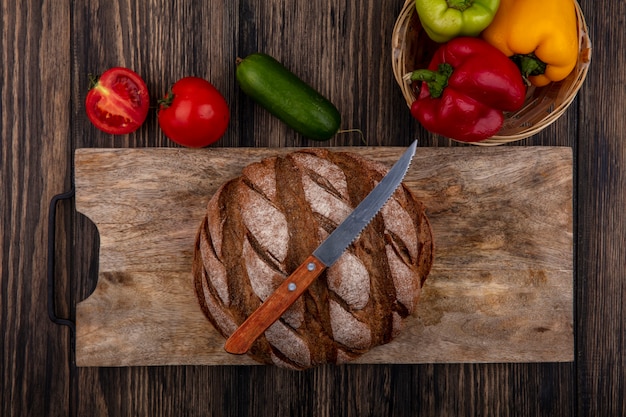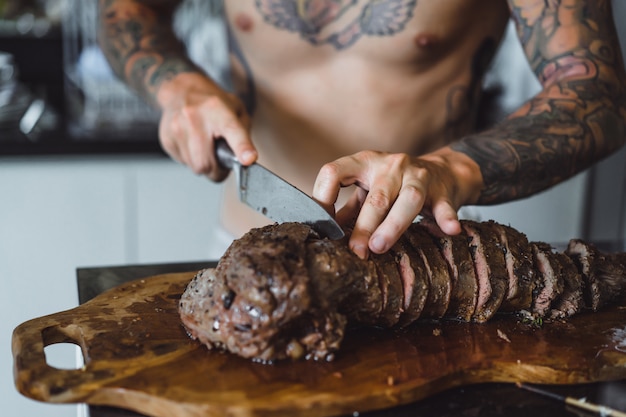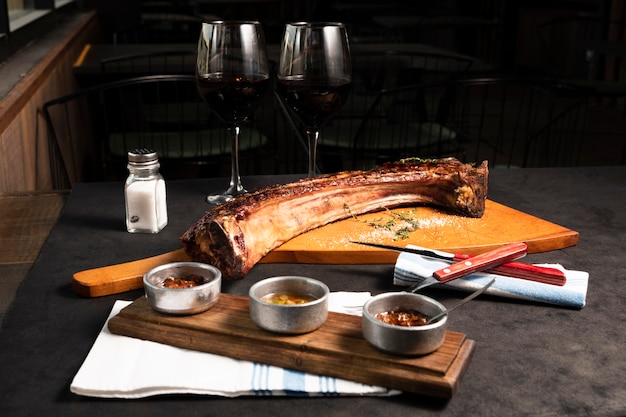Let’s talk ribeye roast. Not just any old roast, mind you. I'm talking about that beautifully marbled, melt-in-your-mouth masterpiece of beef, the kind that makes you lick your plate clean and then crave another bite. That's the kind of ribeye roast we're aiming for today, and believe me, with a little know-how and a whole lot of passion, you can absolutely achieve it. This isn't just a recipe, it's a journey through cuts, techniques, and all the little tricks I've picked up over the years to make sure you end up with a ribeye roast that'll have everyone begging for your secret recipe.
(Part 1) Understanding the Ribeye: The Foundation of Flavor

Before we get into the nitty-gritty of cooking, we need to understand the star of the show: the ribeye. It's a cut of meat that comes from the rib section of the cow, that area between the shoulder and the loin. That's where all the good stuff is, you know? This is why ribeye roast is known for its rich marbling, those beautiful streaks of fat that add both incredible flavor and tenderness.
Choosing Your Ribeye: The First Big Decision
Now, not all ribeye roasts are created equal. You've got to choose between bone-in or boneless, and you might even find options like "prime rib", which is just a fancy name for a bone-in ribeye roast. Personally, I'm a sucker for bone-in. That bone adds a depth of flavour that's just unbeatable. But ultimately, it's all about your personal preference. Whatever you choose, make sure the meat is well-marbled. You want those little streaks of fat running throughout, that's what'll make it melt-in-your-mouth delicious. You can usually find ribeye roasts weighing between 3 to 5 pounds, which is a good size for a family meal. But if you're cooking for a smaller group, you can always ask your butcher to cut a smaller roast for you.
Grading the Ribeye: A Guide to Quality
Then there's the grading. The USDA grading system categorises beef based on marbling, which directly affects flavour and tenderness. You've got your Select, Choice, and Prime. Prime is the king of the hill, boasting the most marbling and the richest flavour. But it's also the priciest. Choice is a fantastic middle ground, offering good marbling and excellent flavour for a more affordable price. Select is the leanest, so it might be a bit drier, but it's the most budget-friendly option.
Don't get hung up on the grade too much, though. If you find a ribeye roast that looks good, feels firm, and has decent marbling, go for it! The grade is just a guideline. Trust your gut and your eyes. Look for a roast with a nice even colour, no signs of bruising or discolouration, and a firm texture.
(Part 2) Prepping Your Ribeye: Unleashing the Flavor

Alright, you've got your ribeye roast, now it's time to prep it for its star turn. This is where you can really start to get creative and make it your own.
Seasoning: The Art of Adding Flavor
Seasoning is key, and the beauty of a ribeye roast is that it takes to just about any flavour profile. You can go classic with salt and pepper, or get adventurous with herbs, spices, or even a dry rub. Here are a few of my personal favorites:
- Classic: Salt, pepper, garlic powder. This simple combo delivers a flavourful foundation for your roast.
- Herby: Rosemary, thyme, garlic, onion powder, salt, pepper. This blend adds a delightful herbal aroma and a touch of earthiness.
- Spicy: Paprika, cayenne pepper, garlic powder, onion powder, salt, pepper. For those who like a kick, this blend delivers a beautiful heat.
- Sweet and Savory: Brown sugar, smoked paprika, cumin, chili powder, salt, pepper. This blend adds a touch of sweetness and smokiness that complements the richness of the ribeye.
Remember, you can always adjust the ratios to your taste, and don't be afraid to experiment! Just make sure to rub the seasoning all over the roast, getting it into all those lovely crevices. It's a good idea to pat the roast dry with paper towels before seasoning, to help the seasoning adhere better.
Resting: Letting the Flavors Mingle
Once your ribeye is seasoned, give it a good rest. I usually pop it in the fridge for at least an hour, but overnight is even better. This gives the seasoning time to penetrate the meat and let those flavours really develop. The longer you rest it, the more intense and complex the flavor will be.
(Part 3) Roasting Your Ribeye: The Heart of the Matter

This is the moment of truth, where you transform your seasoned ribeye roast into a juicy, tender masterpiece. Get ready for a culinary adventure! There are two main ways to cook a ribeye roast: low and slow, or high and hot. I'll guide you through both methods so you can choose the one that best suits your preferences.
Low and Slow: Mastering the Technique
My favorite way to cook a ribeye roast is low and slow. This method ensures even cooking and results in a roast that's tender and juicy throughout. Here's how I do it:
Setting the Stage: Preparing Your Oven
Preheat your oven to 325°F (160°C). Now, here's where things get interesting. You can either place the roast directly on a roasting rack in a baking pan, or you can add a layer of vegetables to the bottom of the pan. Think onions, carrots, potatoes, or even a medley of root vegetables. This not only adds a beautiful side dish but also helps to create a flavorful broth as the vegetables cook. And let me tell you, that broth is pure magic! You can use it to make a delicious gravy later on.
The Roast: Patience is Key
Place the roast in the preheated oven and let it cook for approximately 15 minutes per pound for a medium-rare finish. For a medium finish, add an additional 5 minutes per pound, and for medium-well, add another 5 minutes. The general rule is to cook for 15 minutes per pound for the first hour, then reduce the oven temperature to 275°F (135°C) and continue cooking for another 15 minutes per pound. It's tempting to peek and poke, but try to resist! Let the roast cook undisturbed for the first part of the cooking time. Allowing it to cook undisturbed ensures even heat distribution and a more tender roast.
The Final Touches: Perfecting Your Roast
After the initial cooking time, check the internal temperature with a meat thermometer. For a medium-rare finish, the internal temperature should be around 130°F (54°C). For medium, it should be around 140°F (60°C), and for medium-well, around 150°F (65°C). Once you've reached your desired temperature, remove the roast from the oven and let it rest for at least 15 minutes. This resting time allows the juices to redistribute, resulting in a tender and juicy roast.
High and Hot: Another Approach
If you're after a crispy crust and a juicy interior, you can try a high-heat method. Preheat your oven to 450°F (230°C). Sear the roast on all sides in a hot skillet for about 5 minutes per side. This gives it that beautiful golden-brown crust. Then, transfer the roast to a roasting rack in a baking pan and cook for about 15 minutes per pound, or until the internal temperature reaches your desired level. Again, let it rest for at least 15 minutes before carving. This method is great for smaller roasts, as it cooks faster and results in a crispy exterior.
(Part 4) The Art of Carving: A Masterclass in Presentation
Alright, you've got your perfectly cooked ribeye roast, but now it's time to show it off. Carving is more than just slicing, it's about showcasing the beauty of your culinary masterpiece.
Carving the Roast: The Right Way
If you're working with a bone-in roast, start by carving away from the bone. Slice against the grain of the meat to create tender, juicy slices. For a boneless roast, use a sharp carving knife and cut against the grain, making sure to make even, thin slices. You can even create a beautiful presentation by fanning out the slices on a serving platter. Don't forget to use a carving fork to hold the roast steady while you slice. A good carving knife should be long and sharp, with a slightly curved blade.
The Plate: A Canvas for Your Creation
The plate is your canvas for presenting your perfect ribeye roast. Think about the colours and textures you want to create. Maybe you'll add a dollop of horseradish cream, a sprig of rosemary, or a sprinkle of sea salt. A dash of pan sauce from the roasting pan can add an extra layer of flavour and visual appeal. And don't forget the side dishes! roast vegetables, mashed potatoes, creamy polenta - the possibilities are endless.
(Part 5) Side Dishes: Complements to the Star
Let's face it, a ribeye roast deserves some worthy sidekicks. It's the perfect opportunity to showcase your culinary creativity.
Roasted Vegetables: Bringing in the Colors
Roasted vegetables are a classic companion for a ribeye roast. They add vibrant colour, contrasting textures, and a symphony of flavours. Think roasted carrots, parsnips, Brussels sprouts, or even asparagus. Season them simply with salt, pepper, and a drizzle of olive oil, or get fancy with herbs, spices, and even a touch of honey for a hint of sweetness. For a truly show-stopping presentation, arrange the roasted vegetables around the carved roast on the platter.
Mashed Potatoes: The Creamy Comfort
Mashed potatoes are a timeless comfort food that perfectly complements a juicy ribeye roast. You can keep it classic with butter, milk, and salt and pepper, or elevate it with herbs, cheeses, or even a hint of garlic. For a richer flavor, try adding a dollop of sour cream or creme fraiche.
Other Options: Expanding the Horizons
Want to break away from tradition? Go for something unexpected. A vibrant salad with a tangy vinaigrette, creamy polenta with a sprinkle of parmesan, or even a light and refreshing quinoa salad. The possibilities are endless! A light and refreshing salad can be a nice contrast to the richness of the ribeye.
(Part 6) Beyond the Roast: Putting the Leftovers to Work
Let's face it, a ribeye roast is a feast for the senses, but sometimes you end up with leftovers. Don't let them go to waste! Here are some ideas to put those delicious scraps to good use.
Sandwiches: The Ultimate Leftover Hero
Transform those leftover slices of ribeye into mouthwatering sandwiches. Pile them high on crusty bread with your favourite toppings like cheese, caramelized onions, and a dollop of horseradish cream. You can even add a little bit of arugula for a peppery kick.
Soup: A Flavorful Revival
Add leftover ribeye to a hearty soup for extra protein and flavour. Think beef stew, chili, or even a simple tomato soup. The rich, meaty flavour will add a delicious depth to your soup. For a beef stew, you can add diced potatoes, carrots, and onions, and simmer until the vegetables are tender.
Pasta: A Savory Twist
Combine leftover ribeye with your favourite pasta and sauce for a satisfying meal. Think creamy carbonara, a hearty bolognese, or even a simple tomato sauce with a sprinkle of parmesan cheese. You can also use leftover ribeye to make a delicious pasta salad. Simply toss the ribeye with cooked pasta, chopped vegetables, a vinaigrette, and a sprinkle of parmesan cheese.
(Part 7) The Essential Tools: Your culinary arsenal
You've got the recipe, you've got the ingredients, now it's time to equip yourself with the right tools for the job. This is about having the right equipment to make your ribeye roast dreams come true.
Meat Thermometer: Your Culinary Compass
A meat thermometer is an essential tool for any serious cook. It allows you to monitor the internal temperature of your roast, ensuring it reaches your desired level of doneness. Look for a digital thermometer with a long probe and a clear display. A meat thermometer will take the guesswork out of cooking and ensure that your roast is cooked to perfection.
Sharp Knife: The Key to Perfect Slices
A sharp carving knife is a must-have for carving your ribeye roast. It ensures clean, precise cuts and prevents tearing or shredding the meat. A long, serrated blade is ideal for slicing through the roast with ease. Invest in a good quality carving knife, it's an investment in your culinary skills.
Roasting Pan: Your Culinary Stage
A good roasting pan is essential for creating a delicious and beautifully presented ribeye roast. Look for a pan with a rack to elevate the roast and ensure even cooking. A roasting pan with a rack will help ensure that the roast is cooked evenly and that the juices don't pool at the bottom of the pan.
(Part 8) FAQs: Unveiling the Mysteries
Alright, let's tackle some frequently asked questions. This is your chance to clear up any lingering doubts and become a confident ribeye roast master.
1. What's the best way to keep a ribeye roast juicy?
The key is to cook it low and slow. This allows the internal temperature to rise gradually, giving the fat time to melt and baste the meat, resulting in a juicy and tender roast. You can also add a little bit of liquid to the bottom of the roasting pan, like broth or wine, to create steam and help keep the roast moist.
2. How long should I rest a ribeye roast after cooking?
Resting is crucial for redistributing the juices and creating a more tender and juicy roast. I recommend letting it rest for at least 15 minutes before carving. Cover the roast loosely with aluminum foil while it rests to help trap the heat and moisture.
3. What if my ribeye roast is a bit dry?
Don't despair! You can add moisture by adding a pan sauce or gravy. Use the pan juices from the roasting pan and whisk in a bit of butter or cream for a rich and flavorful sauce. You can also add a splash of wine or broth to the pan juices to create a thicker sauce.
4. Can I freeze a ribeye roast?
You can definitely freeze a ribeye roast, but it's best to wrap it tightly in plastic wrap and then place it in a freezer bag for maximum protection against freezer burn. It can be frozen for up to 3 months. Make sure to thaw the roast completely in the refrigerator before cooking.
5. What's the best way to reheat leftover ribeye roast?
Reheating leftover ribeye roast is a delicate dance. The best approach is to use low and slow heat. You can either reheat it in the oven at 250°F (120°C) for about 20 minutes, or in a skillet over low heat for a few minutes. Avoid high heat, as it can dry out the meat. You can also reheat leftover ribeye roast in a slow cooker on low heat for a few hours.
(Part 9) The Final Word: Embracing the Journey
There you have it, the ultimate guide to cooking a perfect ribeye roast. It's not just a recipe, it's an adventure. An exploration of flavour, technique, and culinary artistry. Don't be afraid to experiment, get creative, and most importantly, enjoy the journey. After all, a perfectly cooked ribeye roast is a celebration of life, a testament to your culinary skills, and a moment to be savored. So go forth and conquer the world of ribeye roast!
Everyone is watching

Corn on the Cob: The Ultimate Guide to Perfectly Cooked Ears
Healthy MealsAh, corn on the cob. Just the name evokes images of sunny days, barbecues, and that sweet, juicy flavour that ...

Scallops: The Ultimate Guide to Perfect Cooking
Healthy MealsAh, scallops. Those delicate, sweet, and utterly delicious morsels of the sea. They hold a special place in my...

Spaghetti Squash: The Ultimate Guide to Cooking and Serving
Healthy MealsRemember that time you saw spaghetti squash at the supermarket, looking all bumpy and strange, and thought, "W...

Salmon Cooking Times: Perfect Guide for Every Recipe
Healthy MealsLet me tell you, cooking salmon is an art form. It's all about getting that perfect balance: juicy and tender,...

Ham Cooking Time: How Long to Bake, Smoke, or Boil a Delicious Ham
Healthy MealsAh, ham. It's a classic, isn't it? A real crowd-pleaser, especially around holidays. And when done right, it'...
